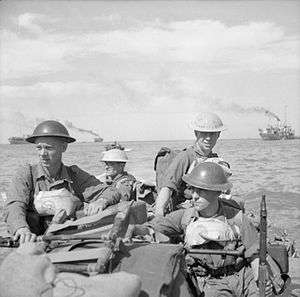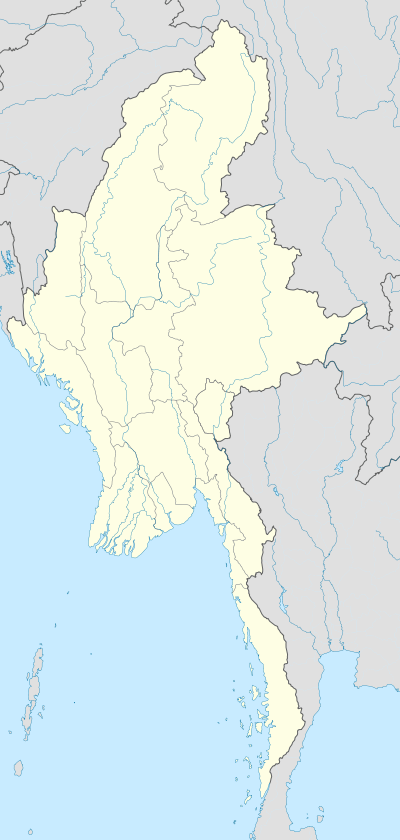Battle of Ramree Island
| ||||||||||||||||||||||||||||||||
The Battle of Ramree Island (also Operation Matador) was fought in January and February 1945, during World War II, as part of the XV Indian Corps offensive on the Southern Front in the Burma Campaign. Ramree Island (Yangbye Kywan) lies off the Burma coast, 70 miles (110 km) south of Akyab (now Sittwe), that had been captured by the Imperial Japanese Army in early 1942, along with the rest of Southern Burma. In January 1945, the Allies launched an attack to retake Ramree and its neighbour Cheduba Island, to establish airbases on the islands for the supply of the mainland campaign.
The battle is associated with reports of many Japanese soldiers being eaten by saltwater crocodiles living in the inland mangrove swamps; these reports are disputed. The Guinness Book of World Records has listed it as "worst crocodile disaster in the world" and "most number of fatalities in a crocodile attack" but scientists and historians have cast doubt on the story.[1][2]
Background
The early capture of Akyab made the 26th Indian Infantry Division (Major-General H. M. Chambers) available for an attack on Ramree Island, 70 miles (110 km) to the south, the island being 50 miles (80 km) long and 20 miles (32 km) wide, flat and an obvious site for airfields.[3] A plan was ready by 2 January, when it was clear that the advance of the Fourteenth Army (Lieutenant-General William Slim) would soon pass beyond the range of its airbases at Imphal and Agartala; replacements at Chittagong, Akyab and Ramree would be needed.[4] On 14 January, the 26th Indian Division was ordered to attack Ramree on 21 January, as a Royal Marine detachment from 3 Commando Brigade occupied Cheduba Island.[5]
The Japanese garrison of Ramree consisted of the II Battalion, 121st Infantry Regiment (Colonel Kanichi Nagazawa), part of the 54th Division, with artillery and engineer detachments to act as an independent force.[6]
Prelude
The battle started with Operation Matador, an amphibious assault to capture the strategic port of Kyaukpyu at the north end of Ramree Island and the airfield near the port, south of Akyab across Hunter's Bay. The invasion force was led by three Joint Assault Commanders, Captain Bush RN, Major-General Cyril Lomax and Wing Commander H. Smith. Reconnaissance carried out on 14 January 1945, found that Japanese forces were placing artillery in caves overlooking the landing beaches on Ramree and the Royal Navy assigned the battleship HMS Queen Elizabeth, the escort carrier HMS Ameer, light cruiser HMS Phoebe, the destroyers Rapid, Napier, Norman and Pathfinder, with the sloops Flamingo and RIN Kistna, to provide more firepower in support of the task force. On 21 January, an hour before the 71st Indian Infantry Brigade (Brigadier R. C. Cotterell-Hill) was to land, the Queen Elizabeth opened fire with 69 rounds of 15-inch (380 mm)-shell from the main battery, while aircraft from the Ameer spotted the fall of shot. Phoebe also joined the bombardment, along with B-24 Liberators, B-25 Mitchells and P-47 Thunderbolts of No. 224 Group RAF, under the command of HQ RAF Bengal and Burma, that strafed and bombed the beaches.[7]
Battle

The assault troops were slightly delayed when a motor launch and a landing craft struck mines but landed unopposed on the beaches west of Kyaukpyu at 9:42 a.m., securing the beachhead by the afternoon. The following day, the 4th Indian Infantry Brigade (Brigadier J. F. R. Forman) landed, took over the beachhead and occupied Kyaukpyu and on 23 January, the 71st Infantry Brigade advanced southwards, down the west coast. Two days later Mayin was occupied and the troops reached the Yanbauk Chaung the next day. Resistance at the chaung from the troops of the II Battalion, 121st Regiment increased and on 31 January, the 71st Brigade was ordered to move inland, north-east towards Sane, then head south towards Ramree town. The 4th Brigade was to keep the defenders at Yanbauk Chaung under pressure and follow up vigorously should they retire.[7]
(On 26 January in Operation Sankey, a Royal Marine force landed on Cheduba island, about 10 kilometres (6.2 mi) from the south-western coast of Ramree Island and found it unoccupied.) On Ramree, the Japanese garrison put up tenacious resistance but on 1 February, the 71st Brigade reached Sane and parts of the 36th Indian Infantry Brigade from reserve took Sagu Kuyun Island and relieved the marines on Cheduba Island.[7] When the British outflanked a Japanese stronghold, the 900 defenders abandoned the base and marched to join a larger battalion of Japanese soldiers across the island. The route took the Japanese across 16 kilometres (9.9 mi) of mangrove swamp and as they struggled through it, the British encircled the area. Trapped in deep mud-filled land, tropical diseases soon started to afflict the soldiers, as did scorpions, tropical mosquitoes and saltwater crocodiles.[8]
On 7 February, the 71st Brigade and supporting tanks reached the town of Ramree and found determined Japanese resistance. The 4th Brigade had advanced to Ledaung Chaung and were sent east to reinforce and the town fell on 9 February. The navy and the 36th Division then concentrated on blockading the chaungs (small streams) on the east coast to prevent the Japanese from escaping to the mainland. A Japanese air raid on 11 February seriously damaged a destroyer with a near miss and forty small craft were sent from the mainland to rescue the survivors of the garrison. Japanese resistance on the island ended on 17 February and the Allied blockade was maintained until 22 February, sinking many of the rescue craft and inflicting many casualties on the Japanese troops hiding in the mangrove swamps; about 500 troops managed to get away. Cheduba Island was not garrisoned and the 22nd East African Brigade was sent to hold Ramree Island.[9]
Aftermath
Analysis
In 1965, the Japanese defence of the island and the escape of about 500 men against "fearful odds", was called courageous and determined by Woodburn Kirby, the British official historian.[8] It took until 16 April for the airfield to be used for transport sorties, Akyab having come into use on 1 April. It had been vital to complete the occupation of Ramree Island quickly, as Operation Dracula against Rangoon needed to commence in the first week of May at the latest, to have a chance of finishing before the monsoon.[3] The experience in co-operation between the 26th Indian Division and the navy in the war of chaungs and small ports along the Arakan coast, was intended to be exploited in the attack. An estimate put naval gunfire support from 4 January – 13 March for the land operations at Akyab, Ramree and Cheduba at 23,000 shells. The navy also carried 54,000 men, 1,000 vehicles, 14,000 long tons (14,000 t) of stores and 800 animals.[10]
Crocodile attack
Some British soldiers, including naturalist Bruce Stanley Wright who participated in the battle, claimed the large population of saltwater crocodiles native to Ramree Island's mangrove swamps preyed on the trapped Japanese force at night and ate many soldiers. Wright gave a description in Wildlife Sketches Near and Far (1962), quoted by Frank McLynn,
That night [of the 19 February 1945] was the most horrible that any member of the M. L. [motor launch] crews ever experienced. The scattered rifle shots in the pitch black swamp punctured by the screams of wounded men crushed in the jaws of huge reptiles, and the blurred worrying sound of spinning crocodiles made a cacophony of hell that has rarely been duplicated on earth. At dawn the vultures arrived to clean up what the crocodiles had left.... Of about one thousand Japanese soldiers that entered the swamps of Ramree, only about twenty were found alive.— Wright[11]
If Wright's claim is true the Ramree crocodile attacks are the worst in recorded history. The British Burma Star Association seems to lend credence to the swamp attack stories but appears to draw a distinction between the 20 Japanese survivors of one attack and the 900 Japanese who were left to fend for themselves in the swamp. There is no corroboration of the event by British military reports or by interviewed Japanese soldiers and local Burmese. As Wright's account is the only known source for the mass crocodile attack and his figures have been disputed by other historians, who call the event an urban myth.[12] On Wright's reporting of the Ramree events, McLynn wrote
Most of all, there is a single zoological problem. If 'thousands of crocodiles' were involved in the massacre, as in the urban (jungle) myth, how had these ravening monsters survived before and how were they to survive later? The ecosystem of a mangrove swamp, with an exiguous mammal life, simply would not have permitted the existence of so many saurians before the coming of the Japanese (animals are not exempt from the laws of overpopulation and starvation).— McLynn[13]
In 1965, the British official history (volume IV, The Reconquest of Burma) had only referred to "crocodile-infested mangrove swamps".[8]
Footnotes
- ↑ Russell 1987, p. 216.
- ↑ Kynaston 1998, p. 135.
- 1 2 Saunders 1975, p. 350.
- ↑ McLynn 2011, p. 433.
- ↑ Woodburn Kirby 2004, pp. 214–215.
- ↑ Woodburn Kirby 2004, p. 215.
- 1 2 3 Woodburn Kirby 2004, p. 219.
- 1 2 3 Woodburn Kirby 2004, p. 220.
- ↑ Woodburn Kirby 2004, pp. 219–220.
- ↑ Allen 1984, p. 468.
- ↑ McLynn 2011, p. 13.
- ↑ Platt et al. 2001, pp. 15–18.
- ↑ McLynn 2011, p. 14.
References
- Allen, Louis (1984). Burma: The Longest War. London: Dent Paperbacks. ISBN 0-460-02474-4.
- Kynaston, Nick, ed. (1998). The Guinness 1999 Book of Records. Guinness Publishing. ISBN 0-85112-070-9.
- McLynn, Frank (2011). The Burma Campaign: Disaster Into Triumph, 1942–45. Yale University Press. ISBN 978-0-300-17162-4.
- Platt, S. G.; Ko, W. K.; Khaing, L. L.; Rainwater, T. R. (2001). BL shelfmark: 4300.326000. "Man Eating by Estuarine Crocodiles: The Ramree Island Massacre Revisited". Herpetological Bulletin. British Library Serials (75). 209068329.
- Russell, Alan, ed. (1987). The Guinness Book of Records 1988. Guinness Books. ISBN 0-85112-873-4.
- St G. Saunders, H. (1975) [1954]. Royal Air Force 1939–45: The Fight is Won. III (repr. ed.). London: HMSO. ISBN 0-11-771594-8. Retrieved 13 December 2015.
- Woodburn Kirby, Major-General S. (2004) [1st. pub. HMSO:1965]. Butler, Sir James, ed. The War Against Japan: The Reconquest of Burma. History of the Second World War, United Kingdom Military Series. IV. Uckfield: Naval & Military Press. ISBN 1-845740-63-7.
Further reading
External links
| Wikimedia Commons has media related to Battle of Ramree Island. |


.jpg)
